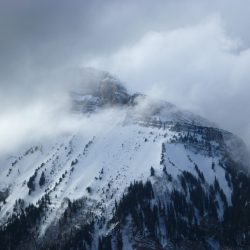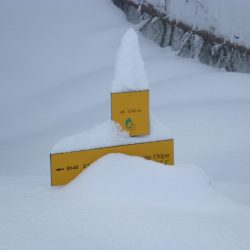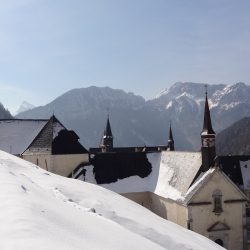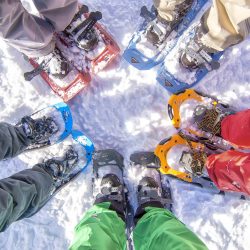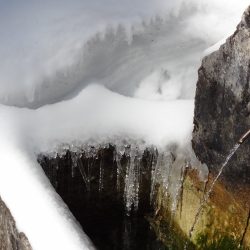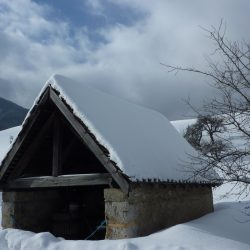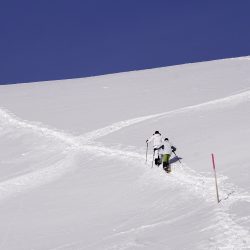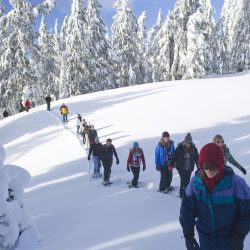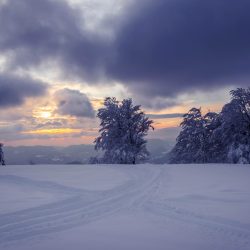We're hoping for fine dry weather and a good snow cover
Clothing :
The principles:
For the upper body, the 3-layer principle makes it possible to manage almost any situation:
a long-sleeved undershirt made from breathable material (hollow fibre).
a warm fleece jacket.
a windproof, waterproof and breathable gore-tex jacket.
When you're out walking in fine, calm weather, an undershirt will suffice. In rain, snow or wind, simply add a waterproof jacket. In very cold weather or during breaks, a fleece jacket is an essential addition.
Make sure your clothes dry quickly, so avoid cotton. Choose wool (merino wool underwear is comfortable and produces few unpleasant odours), silk and synthetic fibres, which keep you dry and warm for as long as possible.
Remember to cover up before you get cold, but above all to uncover before you get too hot. Sweat is the hiker's enemy, because it moistens the clothes, which quickly freeze during breaks. It is therefore very rare to climb a mountain wearing a fleece jacket. Avoid anoraks and ski suits, which are too warm and bulky.
The ideal list: (to be adapted according to the hike and the season)
1 sun hat or cap.
1 scarf or choker.
1 cap.
1 pair of mittens, possibly with silk gloves and an extra pair of gloves.
Short-sleeved T-shirts, preferably made of breathable material (1 for every 2 to 3 days' walking).
1 long-sleeved undershirt made of breathable material or a shirt.
1 fleece jacket.
1 waterproof and breathable gore-tex windproof jacket with hood.
1 rain cape or oversack if you have the jacket above.
1 pair of loose-fitting trekking trousers.
1 pair of waterproof, breathable Gore-Tex overtrousers (budget permitting).
1 pair of pants (can be used in the evening at the stage).
Walking socks (1 pair for 2 to 3 days' walking) Prefer wool or specific hiking socks. Beware of cotton for blisters.
1 pair of waterproof hiking boots with good ankle support and Vibram soles. Remember to "test" new shoes and those that have not been used for a long time beforehand. Absolutely no boots or ski boots.
1 pair of gaiters.
Underwear.
Equipment :
1 35/40-litre soft-framed rucksack with a waist belt for snowshoes.
A large plastic bag to protect the inside of the rucksack.
1 pair of high quality sunglasses with side protection.
1 thermos flask or water bottle, preferably insulated (minimum 1.5 litres).
1 Opinel-type pocket knife.
1 small pouch (preferably waterproof) for your money, identity card, health insurance card and assistance contract.
Toilet paper + 1 lighter to burn it.
Sun cream + sunscreen.
Airtight plastic can (minimum capacity 0.5 l) + cup + cutlery.
1 survival blanket.
Camera, binoculars (optional).
For the evening at your accommodation :
A sheet-bag. Duvets are not necessary.
1 swimming costume (optional).
1 pair of comfortable trousers.
1 pair of light casual shoes.
Toiletries (focus on essentials, small sizes, samples and travel kits).
1 quick-drying towel.
Earplugs or ear plugs (optional).
1 headlamp or torch.
Personal pharmacy :
Your usual medicines.
Pain medication: preferably paracetamol.
Sore throat lozenges.
Elastic adhesive tape, Elastoplast type, 8 cm wide.
Sets of adhesive dressings + disinfectant pads.
Double skin (Compeed or SOS ampoules).
1 pair of tweezers.
And then...
A dose of good humour and why not a little home-grown speciality to share at a picnic or an evening out!


